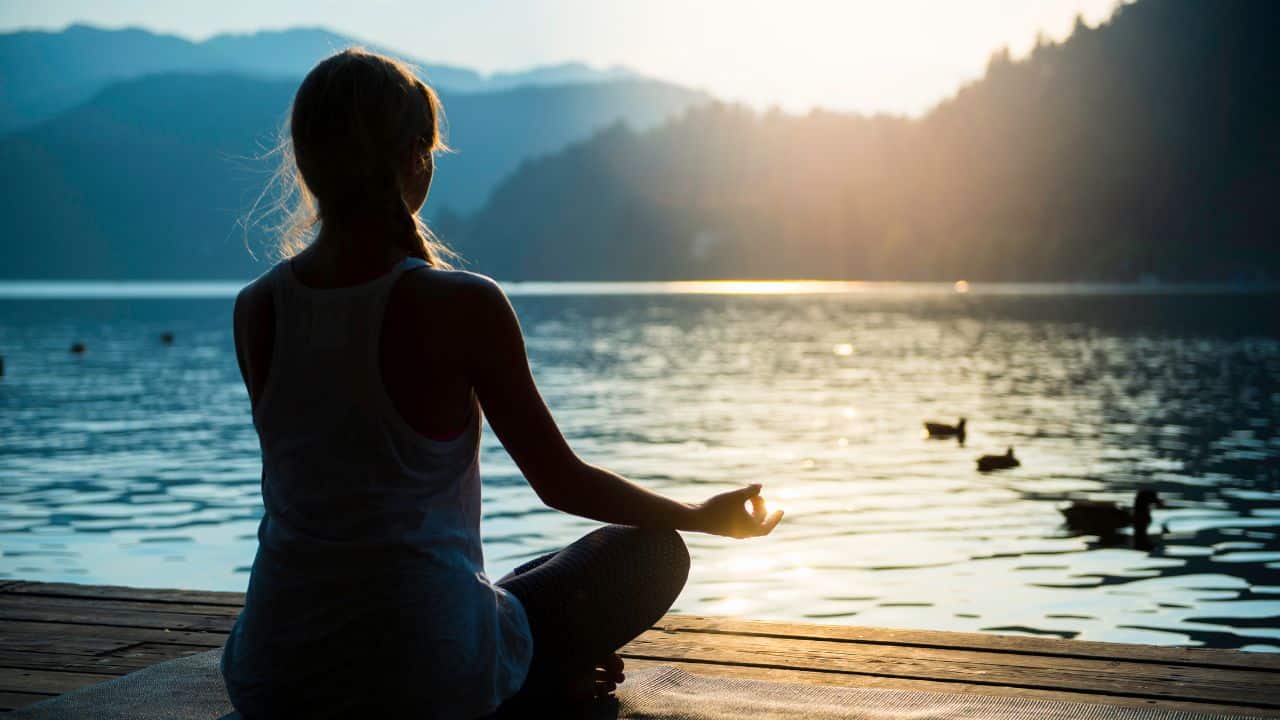What Is Reiki Meditation?

Hello, lovely friends! I am Lisa Beachy, spiritual intuitive and Reiki master. I’m so glad you’re here to learn about the wonderful healing art of Reiki meditation.
Reiki meditation combines the soothing power of meditation with Reiki energy healing. It’s a beautiful way to calm the mind, heal the body, and connect with your highest spirit.
In this article, we’ll gently explore everything you need to know to begin practicing Reiki meditation yourself. I’ll explain what Reiki is, how it works, and the amazing benefits it can provide. You’ll learn about Reiki hand positions, training, and techniques to make your practice really sing!
We’ll softly address any questions or concerns that may come up around this gentle healing approach. My hope is that you feel uplifted and empowered to access Reiki meditation as a tool for ongoing health, happiness and inner peace.
So settle in, take a nice deep breath in, and let’s begin!
What is Reiki?
Reiki is a Japanese healing method that uses energy channeled through the hands. The word Reiki comes from two Japanese words: rei, meaning “universal”, and ki, meaning “life force energy”.
Reiki practitioners believe that a “life force energy” flows through all living things. If someone’s life force energy becomes low, they may get sick or feel constant stress. A Reiki practitioner can channel positive energy into someone by lightly placing their hands on or just above them. This helps facilitate healing.
What are the benefits of Reiki meditation?
Some of the many gifts Reiki meditation offers include:
- Deep rest and lowered stress
- Better mood and happiness
- Less anxiety or gloom
- More pep in your step
- Quicker recovery from surgery or injury
- Sounder sleep
- Sharper focus and awareness
- Letting go of negativity
- Feeling more spiritual and connected
By meditating while receiving Reiki, you boost the perks. Quieting your thoughts allows the energy to flow smoothly and restore your natural state of peace.
How does Reiki meditation work?
In a standard Reiki meditation session, you would sit or lie down comfortably with eyes closed. As the practitioner lightly touches or hovers over different areas of your body, breathe deeply and release any tightness.
You might visualize the energy as shimmering light or gentle waves passing through you. Or repeat uplifting mantras or affirmations silently. The key is being present and letting the Reiki flow.
If self-treating, place your hands where they feel needed and meditate as you direct the energy. Stay centered, observing sensations without judgment.
What are the different hand positions used?
Reiki uses certain hand placements, such as:
- Head and neck – beside ears or cradling head
- Torso – on heart, stomach, back
- Limbs – shoulders, arms, hips, legs, feet
- Chakra centers – along the body’s midline
- Aura smoothing – hands gliding above body
- Distant healing – hands held above body
You remain dressed, with adjustments made for comfort. Each position is held for 3-5 minutes before moving to the next.
What does Reiki meditation feel like?
Reiki often creates feelings of:
- Deep relaxation as tension subsides
- Calm as anxious thoughts drift away
- Warmth or tingling in the body
- Heaviness or lightness in arms and legs
- Emotional releases through laughter or tears
- Mental clarity and renewed energy
- Connection to inner wisdom
- Comforting nurturing sensation
The experience differs from person to person. With regular practice, many find Reiki profoundly centering and healing.
How is Reiki meditation different from regular meditation?
Reiki meditation has some key differences from classic seated meditation:
- Energy channeling – practitioner transfers life force
- Hand placements – body is actively touched
- Self-treatment – can be used to heal yourself
- Full body focus – moves energy to different areas
- Physical sensations – often more intense energy feelings
- Emotional release – surfaces and clears stuck feelings
- Spiritual experience – creates deeper connectedness
However, presence, breath focus, and mindfulness remain essential. Reiki and meditation work beautifully together.
Does it require attunement or training?
To treat others, formal Reiki training and attunement by a Master is advised. But anyone can use Reiki energy for self-care. Placing your hands on areas of pain or imbalance while meditating can support healing.
There are three main levels of Reiki training:
- Level 1 – Self and others, focuses on physical
- Level 2 – Learn symbols, work on mental/emotional
- Level 3/Master – Teach and attune new practitioners
Courses teach techniques, intuitive sensing, distance healing, and professional practice. The investment is very rewarding.
What are some useful techniques to get the most out of Reiki meditation?
Some tips for deeper Reiki meditations include:
- Set your intention or ask for guidance
- Breathe slowly and fully
- Visualize healing light filling you
- Repeat uplifting affirmations
- Feel gratitude, self-love and compassion
- Listen to soft healing music
- Journal to track growth and insights
- Stay well hydrated before and after
- Avoid distractions beforehand
Remaining open and receptive allows Reiki to flow freely.
How often and for how long should it be practiced?
There are no strict rules, but more frequent and longer sessions provide greater benefits. Typical recommendations are:
- Daily self-treatment – 10-20 minutes
- Weekly full session – 60-90 minutes 1-2 times per week
- Group shares – 2 hour monthly community sessions
- Retreats – Weekend to week-long immersive experiences
Daily practice makes Reiki a way of life rather than just a treatment. But even 5 quick minutes can uplift and restore balance. Follow your intuition on what feels right.
Are there any risks or side effects?
Reiki meditation has minimal risks as it works gently with your body’s natural healing ability. But be aware:
- Emotional release – feelings may arise to process
- Detoxification – increase water, rest if needed
- Contraindications – pregnancy, some medical devices
- Psychosis concerns – those with severe mental illness should seek medical guidance
- Delayed treatment – not a substitute if standard care is needed
- Addictive tendencies – maintain healthy balance
Properly trained Reiki practitioners can discuss any specific issues. But Reiki complements other care very safely overall.
Conclusion
In summary, Reiki meditation combines mindfulness with energy healing in a beautiful way. With regular practice, it can help you tap into spiritual wisdom, restore balance, and nurture a sense of inner peace. Reiki is gentle, comforting and deeply revitalizing.
I hope this overview inspires you to explore Reiki meditation as a healing path for your mind, body and spirit. Reiki training is a wonderful investment I highly recommend for all. Please reach out if you have any other questions!
Wishing you light and love along your journey…
What is Reiki Meditation: Summary
| Topic | Description |
|---|---|
| What is Reiki? | Japanese healing technique using life force energy transfer through hands to promote relaxation and reduce stress. |
| Benefits | Deep relaxation, reduced stress, improved mood, pain relief, enhanced energy and immunity, emotional release, better sleep, accelerated healing. |
| How it Works | Receive Reiki from practitioner or self-treat while meditating using mindfulness, breathing focus, mantras, visualizations. |
| Hand Positions | Head, torso, limbs, chakras, aura smoothing, distance healing. Held for 3-5 minutes each. |
| Experience | Relaxation, calmness, warmth, tingling, clarity, spiritual connection. Highly individual. |
| Vs. Regular Meditation | Adds energy channeling, full body treatment, more intense sensations. |
| Attunement | Optional but recommended Reiki training and attunement by a Master. |
| Techniques | Set intentions, breathing, visualizations, affirmations, gratitude, journaling. |
| Frequency | Daily self-treatment, weekly full sessions, monthly groups, retreats. |
| Risks | Emotional release, detoxification, contraindications, psychosis concerns, treatment delays, addiction. Very low risks. |
Frequently Asked Questions
What are the origins of Reiki?
Reiki was developed in 1922 by Japanese Buddhist Mikao Usui, who spent years studying ancient Tibetan healing practices. After fasting and meditating on a mountain, he experienced a mystical enlightenment and ability to channel Reiki energy. Usui passed his teachings down through a lineage of Reiki masters.
How is a Reiki treatment performed?
In a session, you lie fully clothed on a massage table while the practitioner gently places their hands in a series of positions on or just above your body. Each placement is held for 3-5 minutes or more. The practitioner focuses on centering themselves as a channel for transferring Reiki energy into the recipient.
What does Reiki feel like?
Sensations vary but often include feelings of deep relaxation, warmth, tingling, coolness, pulsing, or subtle energy flowing through the body. Some experience emotional releases or spiritual insights during sessions. The energy is guided to where you need healing the most.
Can Reiki cure diseases or replace medicine?
Reiki is not a substitute for qualified medical care. However, it can complement other treatments to help manage pain, anxiety, side effects and stress that may improve treatment outcomes. Reiki supports the whole person rather than just treating isolated symptoms.
Is Reiki safe?
Reiki is generally very safe, gentle and non-invasive. There are few side effects, primarily increased wellbeing. It is not recommended for pregnant women or those with pacemakers due to lack of research on effects. Reiki can safely complement any other treatments.
Can I treat myself with Reiki?
Yes, after receiving an attunement anyone can practice Reiki self-treatment by placing hands intuitively on the body with the intention to heal. Daily self-Reiki practices promote relaxation, vitality and accelerated healing from within.
How do I find a Reiki practitioner?
You can search online directories, ask at holistic wellness centers, or get referrals from healthcare providers. Make sure the practitioner is trained at Reiki Master level and certified. Meet with them first to discuss your needs and establish a comfortable rapport.
or I have my YouTube Readings Channel : Intuitive Aries, Lisa Beachy



0 Comments